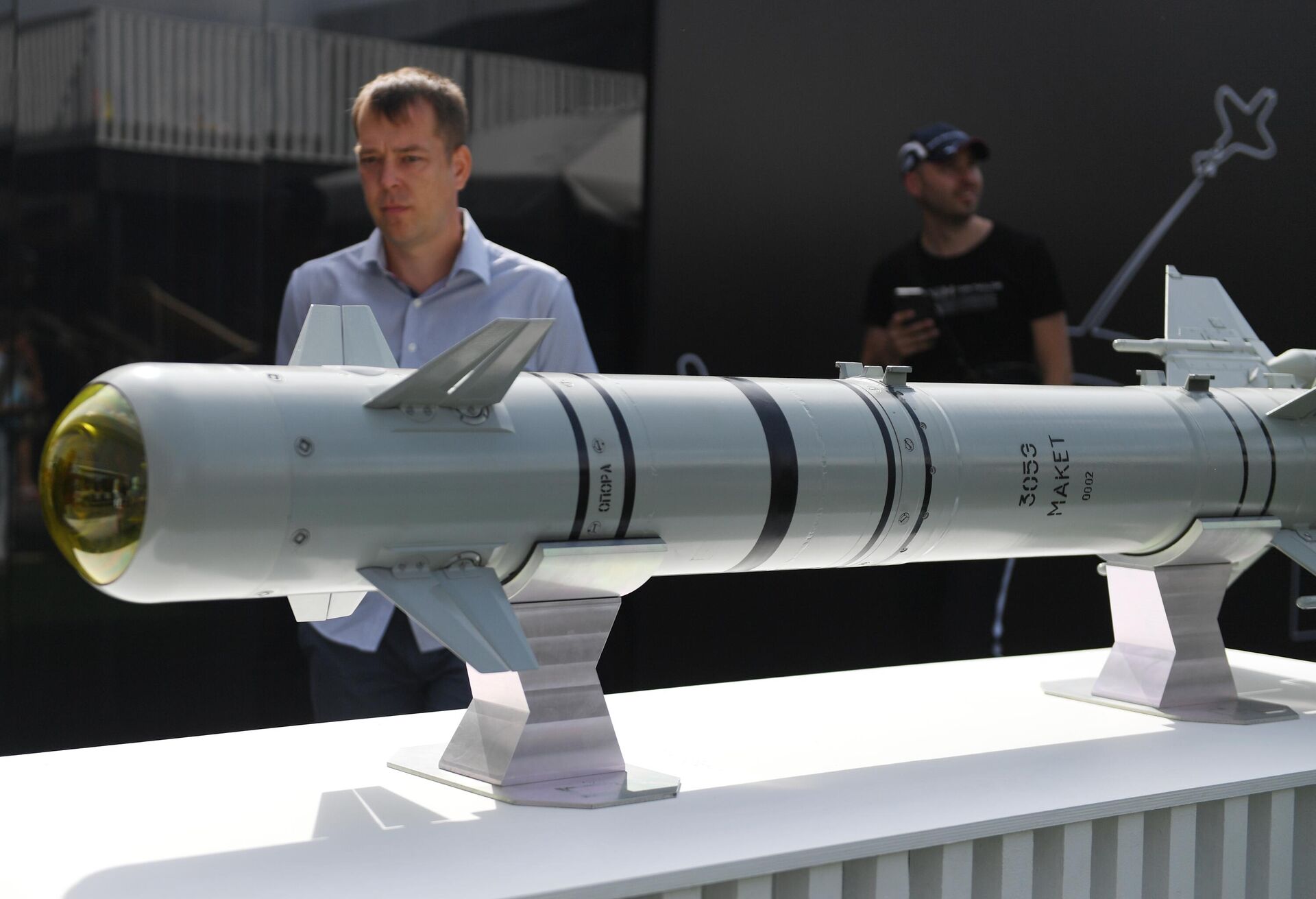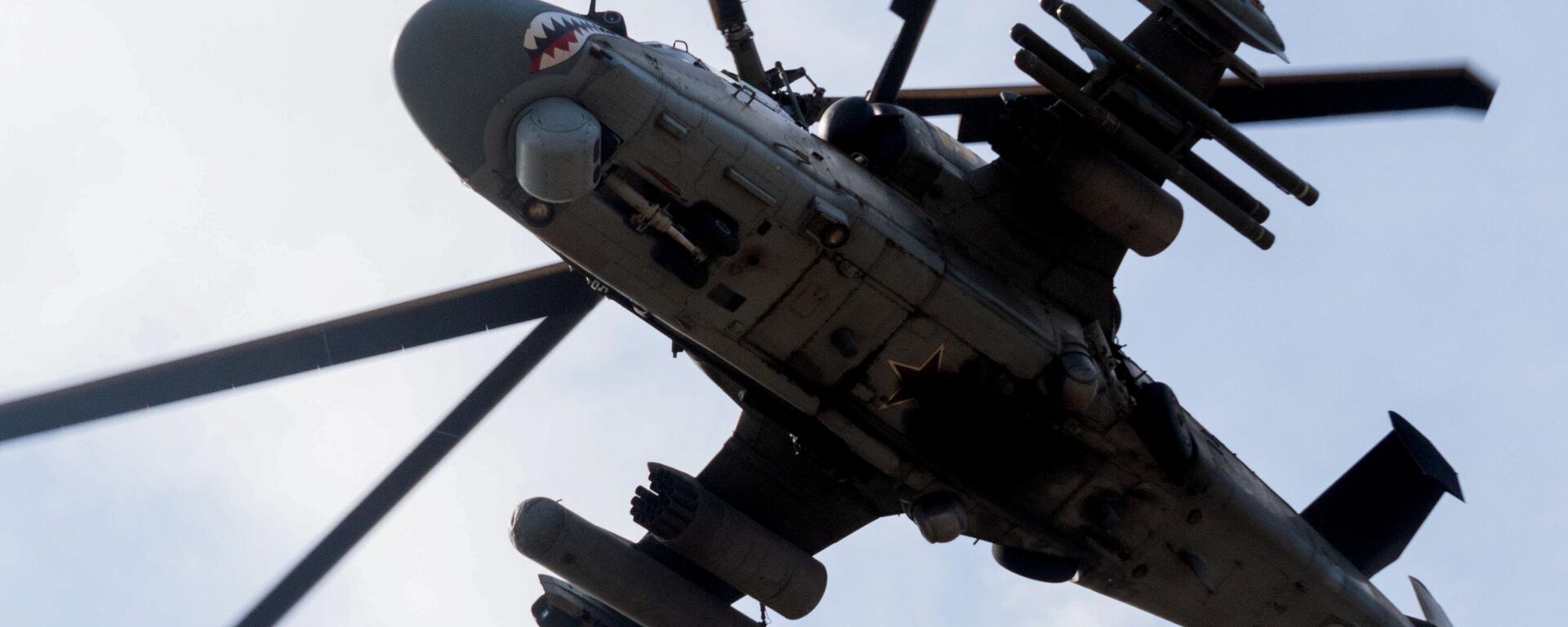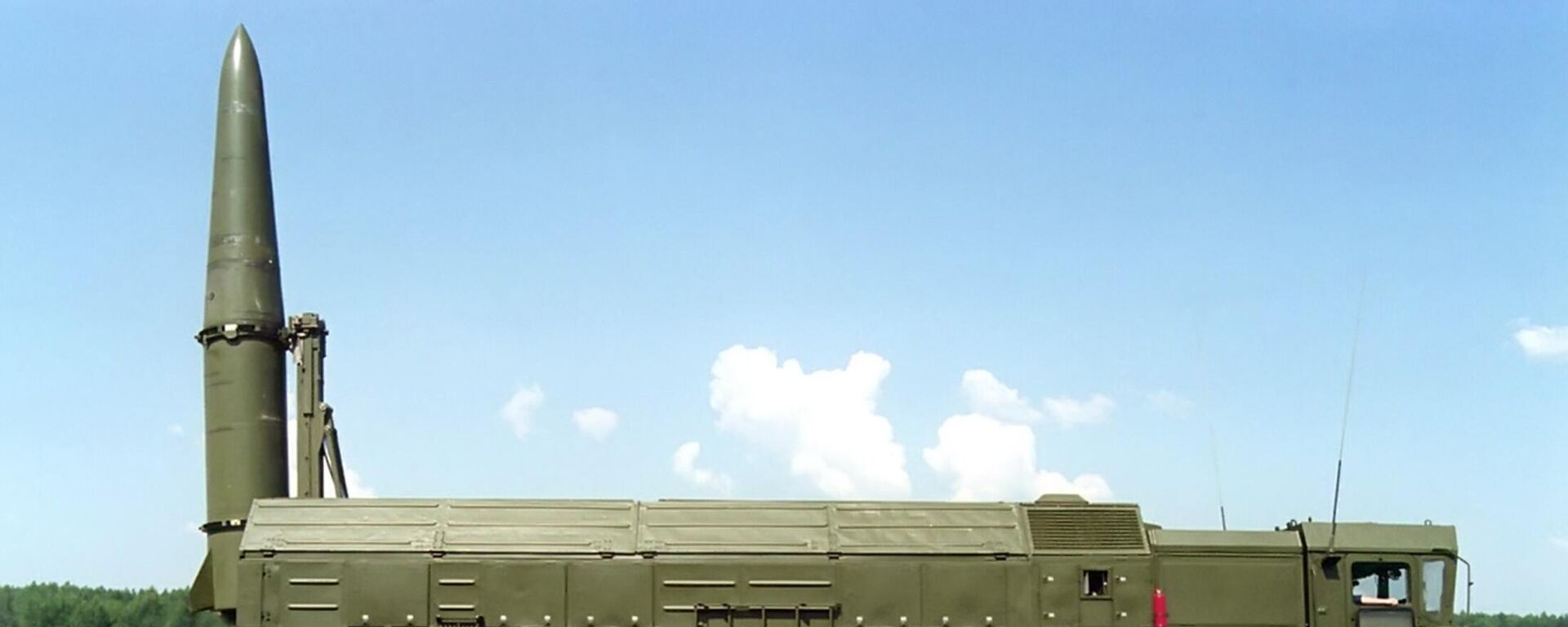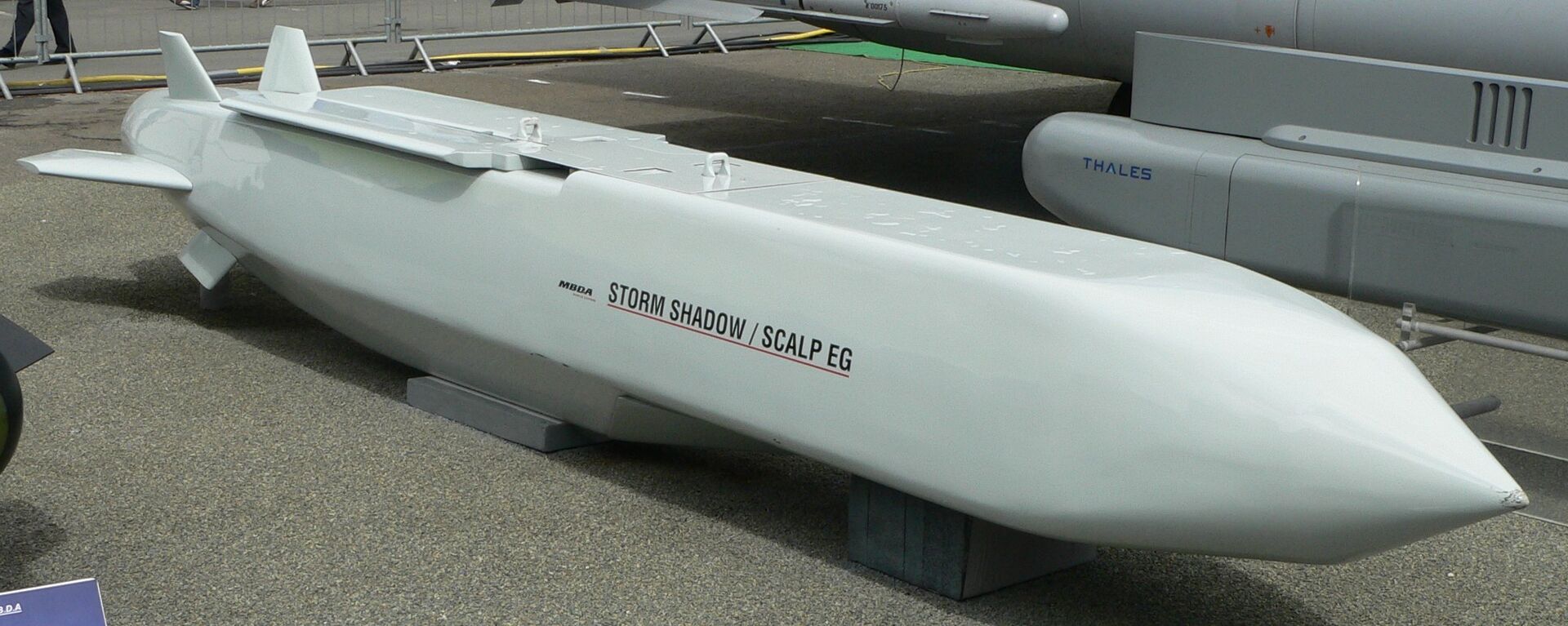https://sputnikglobe.com/20230731/what-are-lmur-missiles-jamming-up-ukraines-counteroffensive-and-why-do-they-make-uk-nervous-1112279085.html
What are LMUR Missiles Jamming Up Ukraine’s Counteroffensive and Why Do They Make UK Nervous?
What are LMUR Missiles Jamming Up Ukraine’s Counteroffensive and Why Do They Make UK Nervous?
Sputnik International
British military intelligence has cited the long-range LMUR missiles used by Russia’s Ka-52M attack helicopters as a major factor challenging the counteroffensive operations of Ukraine’s NATO-armed armies. What exactly is the LMUR? What are its capabilities? Who makes them? And what did UK intelligence get wrong about them? Sputnik explains.
2023-07-31T15:12+0000
2023-07-31T15:12+0000
2023-07-31T15:47+0000
dmiry drozdenko
russia
ukraine
syria
nato
ataka
vikhr
verba
missile
military
https://cdn1.img.sputnikglobe.com/img/07e7/07/1f/1112278688_0:158:3079:1889_1920x0_80_0_0_b30f72233df70315f0509aa5c90ea0b6.jpg
British military intelligence characterized the Ka-52 attack helicopter’s operations in Zaporozhye as “one of the single most influential Russian weapons systems in the sector” in relation to Ukraine’s ongoing attempts to mount an effective counteroffensive.“In recent months, Russia has highly likely augmented the force in the south with at least a small number of brand new, Ka-52M variants: a heavily modified aircraft, informed by lessons from Russia’s experience in Syria," MoD Defense Intelligence said in a July 27 briefing.What is the LMUR?LMUR, the Russian acronym for Light Multipurpose Guided Rocket, also known as Izdeliye 305 (literally "Product 305") is an all-weather, day-night air-launched missile that can be carried by a range of Russian helicopters, including the Kamov Ka-52, the Mil Mi-28 tank hunter, and a Spetsnaz variant of the Mil Mi-8 workhorse transporter known as the Mi-8AMTSh-VN.The LMUR is a fundamentally new weapon, first appearing at military forums in Russia and the Persian Gulf in 2021, and entering into service with the Russian military in the fall of 2022. Limited test run production was carried out in 2016-2017, with the system known to have undergone combat testing in Syria against terrorist targets.The 105 kg missile is fitted with a 25 kg high-explosive fragmentation warhead, and features an inertial-satellite/thermal imaging homing system, including a two-way communication channel for real-time control and manual guidance. The missile can be fired from beyond the line of sight toward specified coordinates, with the thermal imager then used to find and lock on to targets in the final stage of flight.What are LMUR's Tech Specs?The LMUR features a dual x-wing configuration, including four larger stabilizer fins in the rear and four smaller ones toward the front. Two of the rear fins are equipped with a communications datalink. The dome-shaped homing head features cameras and sensor equipment.LMURs are low-flying, with a reported flight ceiling of just 600 meters, and a minimum altitude of 100 m. The missiles fly at speeds up to 230 meters/second, or 828 km per hour, which, when combined with their low altitude flight, make them difficult to detect and destroy before impact.Who Makes LMURs?LMURs are manufactured by KB Mashinostroyeniya, a Moscow region-based state defense, scientific, and design enterprise best known for the production of the Iskander short-range missile system, plus an assortment of Soviet and Russian anti-tank and air defense systems, including the Shturm, Ataka and Malyutka, Verba, Igla, and Strela.What is the LMUR’s Western Analogue?The United States does not have a missile with characteristics comparable to the LMUR in service, although several foreign analogues, including Israel’s Spike fire-and-forget guided missile, France’s Akeron MP, and India’s Nag air-to-surface missile, exist. The guidance of these systems is less sophisticated than the LMUR’s (often limited to fire-and-forget capability, without manual course correction), and they carry smaller warheads. What are the LMUR’s Prospects?The LMUR is a potential game-changer in the sense that it is far cheaper to produce and field than conventional ballistic and cruise missiles, such as the Kh-59, a large air-launched cruise missile with a 200 km range and a 320 kg warhead – which, for use against small concentrations of enemy ground forces, may just constitute overkill.Furthermore, with the ability to be launched from distances up to 15 km, the LMUR has double the firing range of a most of Ukraine’s NATO-provided air defense weapons, including Stinger MANPADs (8 km) and Gepard Flakpanzers (5.5 km from its main guns), making it an effective standoff weapon.What Did UK Intelligence Get Wrong About the LMUR?Dmitry Drozdenko, editor-in-chief of Arsenal of the Fatherland, a Russian online military affairs publication, says there’s one big thing the UK MoD’s Defense Intelligence service got wrong in its assessment of the LMUR. Specifically, he noted, the missile’s large high-explosive fragmentation warhead means it is best used against manpower, light armor, and enclosures, and not so much against tanks.Drozdenko said the LMUR is the first Russian missile capable of firing along the "fire and forget" principle.“Take for example the Vikhr missile, which the Ka-52 has been using successfully against armored vehicles. It needs to be led to its target. In other words, the target must be illuminated by a laser beam, just as with the Ataka missile. The target must be constantly kept in sight, which, in principle, limits the helicopter’s ability to maneuver. If an attack occurs against it at that point, it cannot maneuver fully and must drop its missile guidance and leave the area.”“In the case of the LMUR, it effectively has three guidance options, including ‘fire and forget’ which operates using inertial satellite guidance. That is, when fired, it knows where the target area is. It enters the target area using the inertial system, after which its homing head turns on, which identifies the target and independently destroys it. There is also a more interesting guidance mode from aboard the helicopter. Considering that the missile can fly nearly 15 km – this is very far for any optics. That is, the rocket transmits telemetry data and the image to the operator who, when the rocket has entered the target area, determines himself whether to correct this target…The principle is similar to the Lancet [drone], with the difference being that the Lancet flies slowly, while this rocket flies at 250 meters a second,” Drozdenko explained.
https://sputnikglobe.com/20230729/uk-weighs-in-on-whats-slowing-ukraines-counteroffensive-1112237540.html
https://sputnikglobe.com/20230724/iskander-missile-maker-reports-250-percent-jump-in-production-of-some-missiles-1112106794.html
https://sputnikglobe.com/20230726/experts-no-point-in-russia-copying-captured-western-made-museum-exhibit-missiles-1112167435.html
russia
ukraine
syria
Sputnik International
feedback@sputniknews.com
+74956456601
MIA „Rossiya Segodnya“
2023
News
en_EN
Sputnik International
feedback@sputniknews.com
+74956456601
MIA „Rossiya Segodnya“
Sputnik International
feedback@sputniknews.com
+74956456601
MIA „Rossiya Segodnya“
lmur, missile, russia, uk, ukraine, nato, ka-52, helicopter
lmur, missile, russia, uk, ukraine, nato, ka-52, helicopter
What are LMUR Missiles Jamming Up Ukraine’s Counteroffensive and Why Do They Make UK Nervous?
15:12 GMT 31.07.2023 (Updated: 15:47 GMT 31.07.2023) British military intelligence has cited the long-range LMUR missiles used by Russia’s Ka-52M attack helicopters as a major factor challenging the counteroffensive operations of Ukraine’s NATO-equipped armies. What exactly is the LMUR? What are its capabilities? Who makes them? And what did UK intelligence get wrong about them? Sputnik explains.
British military intelligence characterized the Ka-52 attack helicopter’s operations in Zaporozhye as “one of the single most influential Russian weapons systems in the sector” in relation to Ukraine’s ongoing attempts to mount an effective counteroffensive.
“In recent months, Russia has highly likely augmented the force in the south with at least a small number of brand new, Ka-52M variants: a heavily modified aircraft, informed by lessons from Russia’s experience in Syria," MoD Defense Intelligence said in a July 27 briefing.
"Another key improvement to the Ka-52 fleet is the integration of a new anti-tank missile, the LMUR, which has a range of approximately 15 km. Ka-52 crews have been quick to exploit opportunities to launch these weapons beyond the range of Ukrainian air defenses,” the
briefing added.
LMUR, the Russian acronym for Light Multipurpose Guided Rocket, also known as Izdeliye 305 (literally "Product 305") is an all-weather, day-night air-launched missile that can be carried by a range of Russian helicopters, including the Kamov Ka-52, the Mil Mi-28 tank hunter, and a Spetsnaz variant of the Mil Mi-8 workhorse transporter known as the Mi-8AMTSh-VN.
The LMUR is a fundamentally new weapon, first appearing at military forums in Russia and the Persian Gulf in 2021, and entering into service with the Russian military
in the fall of 2022. Limited test run production was carried out in 2016-2017, with the system known to have undergone combat testing in Syria against terrorist targets.
The 105 kg missile is fitted with a 25 kg high-explosive fragmentation warhead, and features an inertial-satellite/thermal imaging homing system, including a two-way communication channel for real-time control and manual guidance. The missile can be fired from beyond the line of sight toward specified coordinates, with the thermal imager then used to find and lock on to targets in the final stage of flight.
What are LMUR's Tech Specs?
The LMUR features a dual x-wing configuration, including four larger stabilizer fins in the rear and four smaller ones toward the front. Two of the rear fins are equipped with a communications datalink. The dome-shaped homing head features cameras and sensor equipment.
LMURs are low-flying, with a reported flight ceiling of just 600 meters, and a minimum altitude of 100 m. The missiles fly at speeds up to 230 meters/second, or 828 km per hour, which, when combined with their low altitude flight, make them difficult to detect and destroy before impact.
LMURs are manufactured by KB Mashinostroyeniya, a Moscow region-based state defense, scientific, and design enterprise best known for the production of the Iskander short-range missile system, plus an assortment of Soviet and Russian anti-tank and air defense systems, including the Shturm, Ataka and Malyutka, Verba, Igla, and Strela.
What is the LMUR’s Western Analogue?
The United States does not have a missile with characteristics comparable to the LMUR in service, although several foreign analogues, including Israel’s Spike fire-and-forget guided missile, France’s Akeron MP, and India’s Nag air-to-surface missile, exist. The guidance of these systems is less sophisticated than the LMUR’s (often limited to fire-and-forget capability, without manual course correction), and they carry smaller warheads.
There’s also one other important distinction between them and LMUR. But more on that below.
What are the LMUR’s Prospects?
The LMUR is a potential game-changer in the sense that it is far cheaper to produce and field than conventional ballistic and cruise missiles, such as the Kh-59, a large air-launched cruise missile with a 200 km range and a 320 kg warhead – which, for use against small concentrations of enemy ground forces, may just constitute overkill.
Furthermore, with the ability to be launched from distances up to 15 km, the LMUR has double the firing range of a most of Ukraine’s NATO-provided air defense weapons, including Stinger MANPADs (8 km) and Gepard Flakpanzers (5.5 km from its main guns), making it an effective standoff weapon.
In other words, the helicopter carrying the missile can fire and return to base without ever being endangered by the adversary’s air defenses.
What Did UK Intelligence Get Wrong About the LMUR?
Dmitry Drozdenko, editor-in-chief of Arsenal of the Fatherland, a Russian online military affairs publication, says there’s one big thing the UK MoD’s Defense Intelligence service got wrong in its assessment of the LMUR. Specifically, he noted, the missile’s large high-explosive fragmentation warhead means it is best used against manpower, light armor, and enclosures, and not so much against tanks.
“It is very good at defeating an enemy who is in some kind of shelter or a building. Because while cumulative warheads like those in the Vikhr or Ataka are designed to break through enemy armor,” in the case of the LMUR, “a high-explosive fragmentation warhead flies out, and has completely different damage characteristics. Because the Vikhr and the Ataka will burn a hole and won’t have much of an effect inside a large room. Whereas with the LMUR’s 25 kg high-explosive warhead will destroy everything inside,” Drozdenko told Sputnik.
Drozdenko said the LMUR is the first Russian missile capable of firing along the "fire and forget" principle.
“Take for example the Vikhr missile, which the Ka-52 has been using successfully against armored vehicles. It needs to be led to its target. In other words, the target must be illuminated by a laser beam, just as with the Ataka missile. The target must be constantly kept in sight, which, in principle, limits the helicopter’s ability to maneuver. If an attack occurs against it at that point, it cannot maneuver fully and must drop its missile guidance and leave the area.”
“In the case of the LMUR, it effectively has three guidance options, including ‘fire and forget’ which operates using inertial satellite guidance. That is, when fired, it knows where the target area is. It enters the target area using the inertial system, after which its homing head turns on, which identifies the target and independently destroys it. There is also a more interesting guidance mode from aboard the helicopter. Considering that the missile can fly nearly 15 km – this is very far for any optics. That is, the rocket transmits telemetry data and the image to the operator who, when the rocket has entered the target area, determines himself whether to correct this target…The principle is similar to the Lancet [drone], with the difference being that the Lancet flies slowly, while this rocket flies at 250 meters a second,” Drozdenko explained.






